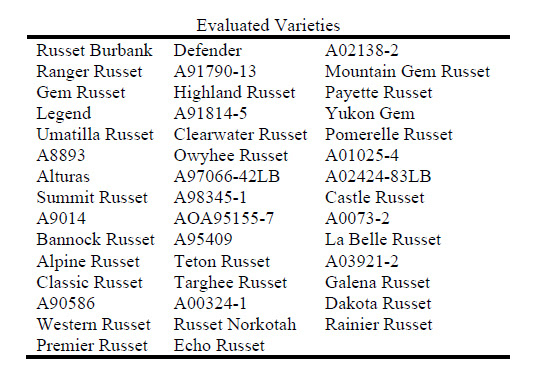Sep 20, 2022History of the University of Idaho Potato Storage Project
 Understanding storage requirements of new potato varieties can have a profound effect on processing and fresh pack quality and financial wellbeing of growers. Many variables including temperature, ventilation, humidity, variety, disease, and physiological tuber age impact the length of time that potatoes can be stored and the quality of the tubers following storage.
Understanding storage requirements of new potato varieties can have a profound effect on processing and fresh pack quality and financial wellbeing of growers. Many variables including temperature, ventilation, humidity, variety, disease, and physiological tuber age impact the length of time that potatoes can be stored and the quality of the tubers following storage.
Most commercial potato storages hold anywhere from 50,000 to 250,000 cwt of potatoes, which represent a large portion of a grower’s economic return. Potatoes are stored from one to 10 months depending on the supply needs of customers. During this time, maintaining usable quality is critical for providing potatoes to processors and fresh pack sheds that meet the needs of customers’ specifications and pack plans. Without guidance, growers and storage managers must experiment on their own with identifying ideal storage conditions for their varieties and risk unforeseen problems that could impact their economic returns.
To help growers and storage managers have a starting point for storing new potato varieties, whether they were developed in the Pacific Northwest (PNW) or imported from other breeding programs, the University of Idaho has evaluated storage responses and recommendations for over 40 different varieties.

The University of Idaho storage project was started during the 1998-99 storage season with the varieties Russet Burbank, Ranger Russet, Gem Russet, Legend, and Umatilla Russet and continued until the 2016-17 season, when departures of key personnel forced the project to be discontinued. In 2020, the project was initiated again with support from the industry with the continued goal of evaluating and developing storage recommendations for new varieties.
Three to five varieties, including Russet Burbank as a control, are planted at the Kimberly Research and Extension Center and grown for 110-120 days. Once varieties are harvested, an initial assessment is performed to provide baseline information on reducing sugar concentrations, fry color, and an initial weight for weight loss measurements. Sub-samples are placed into storage at 42° F, 45° F, and 48° F, and re-evaluated monthly for nine months beginning in October and ending in June.
Chlorpropham (CIPC) is used to maintain sprout control. Each month provides data on the change in reducing sugars, fry color, weight loss, and dormancy. Other assessments made include fusarium dry rot and bruise susceptibility because these injuries and infections can seriously affect storability in some varieties.
The data generated from this project are used to make recommendations for the potato industry. Beginning in the 2022-23 storage season, the project will also be able to generate respiration data of the different varieties, which may help in determining best management practices and storage conditions.
Potatoes are a major source of revenue for the PNW and understanding how to effectively tailor storage conditions to different varieties to maximize quality during storage impacts all aspects of the supply chain from farm operations to the consumer. After two to three years of intensive scrutiny, storage management bulletins are written and posted at . These bulletins provide a comprehensive summary of the various studies.
– R. Rhett Spear, University of Idaho; Nora Olsen, University of Idaho







